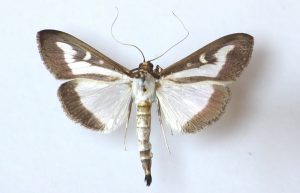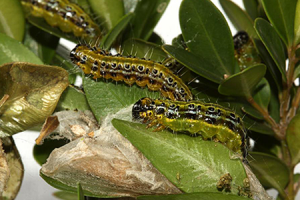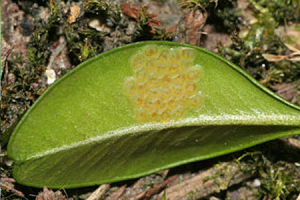Boxwood (Buxus spp.) is a non-native, ornamental shrub that can reach heights between 6 to 8 feet and is widely incorporated into residential and commercial landscapes (USDA hardiness zones 6 through 8). With numerous cultivars available in the nursery trade, common arthropod pests of this woody ornamental typically include the boxwood leafminer (Monarthropalpusi flavus), boxwood mite (Eurytetranychus buxi), boxwood psyllid (Cacopsylla busi), Japanese wax scale (Ceroplastes ceriferus), and various nematode species. Many boxwood varieties are also susceptible to diseases such as boxwood blight (Cylindrocladium psuedonaviculatum), root rot (Phytophthora spp.), and Volutella blight (Pseudonectria buxi).

Recently, USDA-APHIS confirmed the presence of a new pest on boxwood, the boxwood moth (Cydalima perspectalis) in the continental United States. Native to Asia the boxwood moth was first observed outside of its native range in Europe in 2007. It has been proposed that this pest was introduced through a nursery trade shipment from Ontario, Canada to 25 retail facilities in Connecticut, Massachusetts, Michigan, New York, Ohio, South Carolina, and Tennessee. Following this observation, USDA-AHPIS issued a federal order halting the continued import of potential host plants from Canada including boxwood (Buxus spp.), Euonymus species, and holly (Ilex spp.).

Larvae (caterpillars) cause damage to these woody ornamentals while feeding on foliage and eventually, bark tissue. This continued feeding ultimately leads to girdling and plant death. Other symptoms or signs of this pest may include webbing between the leaves, and egg masses on lower leaf surfaces.

Larval development may take anywhere from 17 to 87 days, depending on climatic effects of the region. Boxwood moth will overwinter in its larval form, protecting itself with a cocoon spun between the foliage of the boxwood tree. Due to an overall lack of natural enemies in areas of current invasion, the boxwood moth can reach high densities quite rapidly, limited only by a lack of nutrient resources.
Nursery retailers and homeowners can help prevent the spread of this pest by allowing State or Federal agricultural officials to inspect your boxwood trees, placing insect traps if deemed necessary. If you have purchased a boxwood plant recently, be sure to inspect for this pest and report any potential sightings to your local county extension office, USDA office, or your State agricultural department.
For more information on this pest, be sure to check out the following resources: CABI Boxwood moth, APHIS Contain and Eradicate the Pest, Penn State Extension- Boxwood Moth.
 0
0
